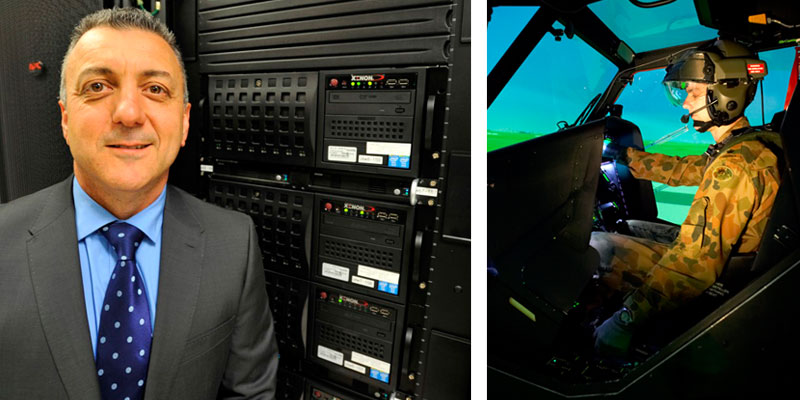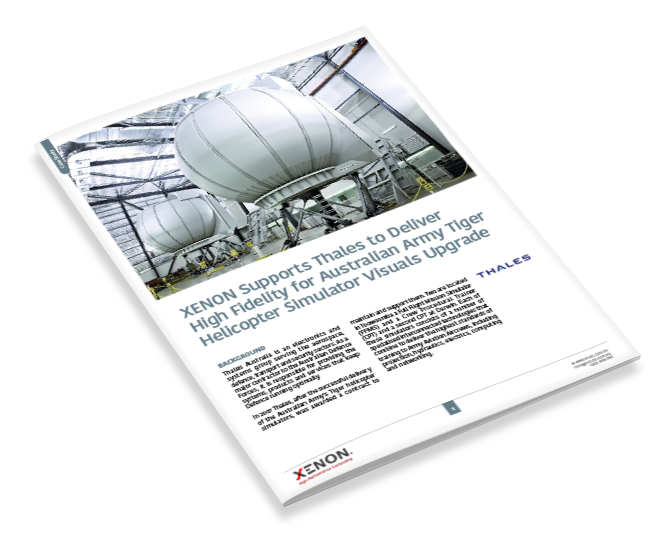XENON Supports Thales To Deliver High Fidelity For Australian Army Tiger Helicopter Simulator
20 Jan 2015
Melbourne, Jan 20, 2015 – Thales had originally sourced hardware from specialist high performance computing consultancy, XENON, and was familiar with the quality of its previous solutions.
The solution created by XENON
Thales had originally sourced hardware from specialist high performance computing consultancy, XENON, and was familiar with the quality of its previous solutions. Based on this experience, Thales consulted XENON again both for hardware and technical design, to understand what would deliver the latest processing power and highest visual fidelity system.
With experience in working with research, scientific and entertainment organisations including CSIRO, NeCTAR and ICAA (Independent Cinema Association of Australia) among others, XENON has carved out a strong reputation for designing and delivering high performance specialised solutions that provide compute processing, user experience and cost benefits. Thales contracted XENON to design the hardware and network infrastructure for the operating system and management software, and then provide prototypes to Thales Australia to load its own software and deploy across the image generators for delivery to the projectors.
“Delivering systems to the Armed Forces is not like mass producing a car. It’s a highly specialised and highly critical technical environment that requires niche expertise. Simulator downtime needs to be accounted for, minimised and planned to the most precise point, all while keeping personnel trained, projects on time and costs within budget.“
Programme Manager, Thales Australia
XENON delivered a multi-layered solution. Image generators are based on NVIDIA Quadro professional graphics with Qsync technology, dual Xeon processors with Error Correcting memory in a rack mount enclosure with redundant cooling, power and storage. These were designed for maximum uptime through built-in redundancy, world class graphics performance with Qsync capabilities to allow all the image generators to run in sync and all this was done on industry standard commercial off-the-shelf (COTS) equipment which delivers cost savings over proprietary designed equipment.
 Harry Tavlaridis, Air87 ARH Tiger ATDs TLS Programme Manager for Thales Australia, in the datacentre where the XENON Image Generators are housed.
Harry Tavlaridis, Air87 ARH Tiger ATDs TLS Programme Manager for Thales Australia, in the datacentre where the XENON Image Generators are housed.This was based on centralised storage. To maximise uptime, XENON built a High Availability network attached storage (NAS) solution that works in an active/passive mode. Centralised storage design lowers the total cost of ownership on support of the simulator and increases the uptime and manageability.
Finally, the network was designed around a stack of Extreme Networks switches that are partitioned into five virtual LANs. The benefit of this design over the previous network design is to lower the number of switches by half while adding new networks. The XENON design also included 10GigE connectivity for the NAS servers to deliver full non-blocking Gigabit performance to each image generator.
All of this was managed virtually at XENON’s specialist lab in Melbourne, where the company also did factory acceptance testing and then dismantled and shipped the equipment for a site acceptance test at the simulator’s location in Toowoomba. Once reassembled XENON also provided maintenance training for Thales simulator technicians.
“Increasingly organisations are recognising the value of highly specialised organisations, such as XENON, that have deep expertise in consulting on, and delivering, complex projects within specified timeframes and budgets. “In fact, on this occasion, we delivered the upgrade back it into service ahead of time” added Mr Tavlaridis.
If you’d like to learn more about XENON’s HPC solutions, please contact us or call 1300 888 030.
Talk to a Solutions Architect
 Download the XENON-Thales Australia Case Study
Download the XENON-Thales Australia Case Study

